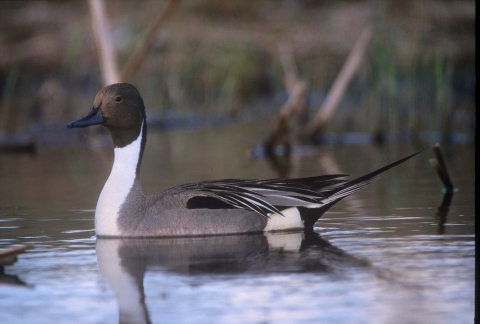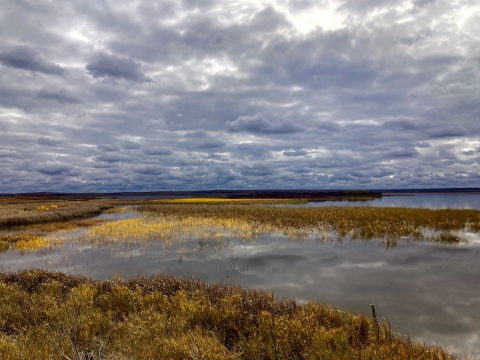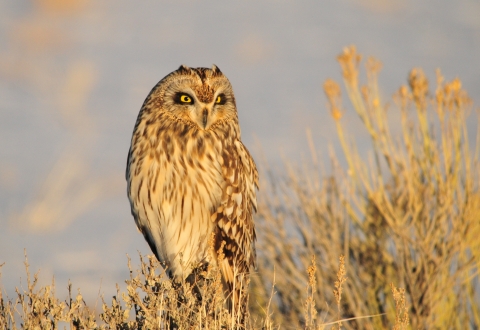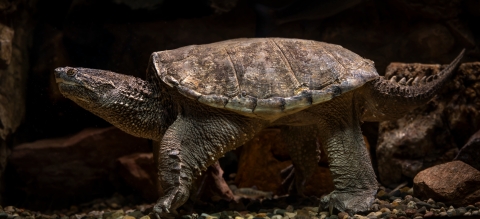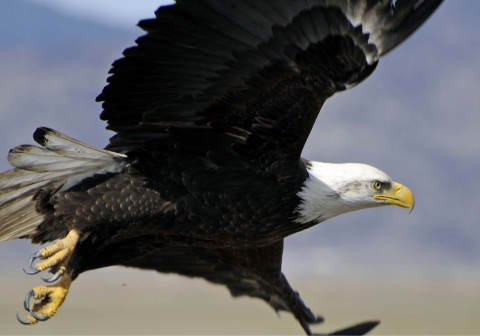Seasons of Wildlife
Spring
Spring (March-May) rushes in as the ice and snow melts and the days begin to lengthen. Northern pintails are the first arrivals of spring. When the first drake pintails arrive in late February, spring is around the corner. In some years, winter gives way readily and by March the temperatures are mild and many early season plants begin to green up. Other years, winter hangs on well into April. It is certain, however, that spring will bring many migratory birds to the Refuge that stop to feed and rest before moving on. Some will stay to nest and raise young.
Summer
By early June, spring has faded into summer (June-August). Spring migration is complete, and the species that remain are busy raising young. Plants actively grow through the summer months, producing the vegetation, seeds, and tubers that will feed the wildlife that visit the Refuge until the next year.
Autumn
Summer begins to fade into fall (September-October) during the month of September. Some years, the heat of summer remains till the end of September and some years the cooler fall temperatures arrive in early to mid-September. The fall migrants begin to move ahead of the winter that is to come. The first trumpeter swans arrive in September when their cygnets (young swans) learn to fly.
Winter
The first snow of the season signals the arrival of winter (November-February). Many of the migratory bird species have moved on. Some species, such as mallards, Canada geese, bald eagles, and rough legged hawks arrive to spend the long winter with us.
Featured Species
Birds
The concentration of wetland, grassland, and cropland found on and adjacent to the Refuge provides habitat for a very diverse bird population. A total of 282 different bird species have been recorded at the Refuge since 1959. The majority of bird species common to the Great Plains can be found here, along with some unique species for South Dakota. Trumpeter swans were released on the Refuge in the early 1960s. A high count of 500 was recorded in January of 2022, with 100 to 300 typically present from October through March. Lacreek National Wildlife Refuge is one of the few places in South Dakota where you may hear both an eastern and a western meadowlark while standing in the same location. American bitterns are commonly observed at the Refuge from April through September.
Fifty-one species of waterfowl, pelicans, cormorants, herons, and ibises use the Refuge for migration and/or nesting. Forty-four species of rails, plovers, turnstones, sandpipers, stilts and gulls have been documented on the Refuge. Of those, 16 species nest here. Twenty-five species of hawks, falcons, eagles (bald and golden), and owls hunt the Refuge's abundant prey base. Lacreek National Wildlife Refuge is a great place to see many of the Great Plains representative bird species along with a chance for some unique ones.
Short eared owls, like the one pictured here, hunt the grasslands for prairie voles and other small mammals.
Please click here for a complete list of birds identified on the Lacreek NWR.
Mammals
Refuge habitat supports a wide diversity of mammals that are commonly found on the Great Plains. Wetlands host species such as muskrat (shown here), beaver, mink, short-tailed and long-tailed weasel, raccoon, white-tailed deer, and meadow voles. The grasslands support species such as mule deer, black-tailed prairie dog, badger, deer mice, Ord's kangaroo rat, white-tailed jackrabbit, thirteen-lined ground squirrel, and coyote.
Fish
The springs which flow through the Refuge support the pearl dace and northern redbelly dace. Both of these fish are listed by the State of South Dakota as Threatened and are a unique Refuge inhabitant. The Trout Ponds support rainbow trout which are stocked twice each year for recreational fisheries. The Little White River Recreation Area was drawn down and renovated in 2007, and was restocked with channel catfish, yellow perch, bluegill, largemouth bass, northern pike, and walleye in 2008. The remainder of the Refuge's wetlands are managed for migratory birds and are periodically drawn down and allowed to dry out in the summer months. This limits the number and species which survive. Common carp, black bullhead, and fat head minnows are some of the only species which can find limited locations to survive the drawdowns and repopulate the wetlands when filled again. These three fish species are a common prey item for the many species of heron, egret, bittern, grebe, pelican, cormorant, merganser, goldeneye, tern, and eagles which call the Refuge home, be it temporary or permanent.
Insects
A diversity of insects typically found in prairie and wetland environments are present at Lacreek Refuge. Many of our management practices include increasing or maintaining our abundance of insects for prairie and wetland birds as a management objective. Research has shown that insects play a key dietary role for birds that help with egg laying, feather replacement, and muscle tissue growth. Reseeding a diverse mix of grassland plant species provides more opportunities for insects to complete lifecycles. Managing wetlands through prescribed fire and grazing, seeding a diverse mix of native plants, and water level manipulations increases the amount of desirable plant material available for aquatic insects to feed on and complete lifecycles.
Butterflies, like this monarch, are part of a diverse group of insects that are often very noticeable. There have been 47 species of butterflies documented at the Refuge. Many are attracted to showy wildflowers such as milkweed and goldenrods. Many are tiny and rarely noticed, living out their lifecycles in the grasslands. A few, such as the regal fritillary, are uncommon and are only found on unbroken tracts of native prairies.
Reptiles and Amphibians
The Northern Great Plains long cold winters limit the abundance and diversity of reptile and amphibian species which can survive here. A number of snakes live here due to the abundant food. Prairie rattlesnakes prefer the open ground of the black-tailed prairie dog towns and often retreat into a burrow to escape the heat of the day. They generally avoid the wetlands and denser vegetation of the uplands that bull snakes prefer. The plains garter snake is common while other species include the hognose snake and the green racer. Lizards are a rare sight at Lacreek National Wildlife Refuge. The Sandhills supports the lesser earless lizard, prairie lizard, and many-lined skink; species generally only found in the Sandhills portion of South Dakota. Several species of frogs can be heard more often than they are seen. The boreal chorus frog, northern leopard frog, bullfrog, and plains spadefoot are the most common. The painted turtle and the snapping turtle (below) are found in the Refuge's wetlands. They survive the winter by burrowing into one of the many springs and seeps.
Endangered Species
The federally endangered whooping crane migration route passes over Lacreek National Wildlife Refuge. Whooping cranes have been identified in years past, but have not been documented in several years. They generally stay a night or two and then continue on. The federally threatened American burying beetle was documented as occurring in Bennett County in 2007. Past surveys of the Refuge have not detected this species. Suitable habitat and the nearby sighting makes it likely that American burying beetles may be found on the refuge and have yet to be detected.
The federally threatened western prairie fringed orchid has not been detected in previous surveys. Suitable habitat exists, and it is possible that it is present at such a low frequency that it has not been detected. Future surveys are planned.
The State of South Dakota maintains a threatened and endangered species listthat designates species of concern that occur in low numbers or in restricted habitats. The bald eagle, osprey and peregrine falcon are included on the state threatened list. Lacreek National Wildlife Refuge had one nesting pair of bald eagles that successfully fledged at least one eaglet in 2006 and 2007. Currently, in 2022, there are three pair of nesting bald eagles. We will see how many eaglets result! Up to 100 bald eagles may be present during December through March when large concentrations of waterfowl or winter killed fish are present.
Osprey are rarely sighted at the Refuge; however, a half dozen or more sightings are recorded on the Refuge each fall and spring of peregrine falcons. Peregrines are usually spotted hunting shorebirds or teal on the Refuge. Piping plovers are listed as state threatened and are rarely sighted on the Refuge during migration.
The swift fox is also listed as threatened in South Dakota. Although swift fox releases have been made to the west of the Refuge, only one potential sighting has been documented on the Refuge.
The pearl dace and northern redbelly dace are state listed as threatened fish in South Dakota and both can be found in the Refuge's spring fed streams.



